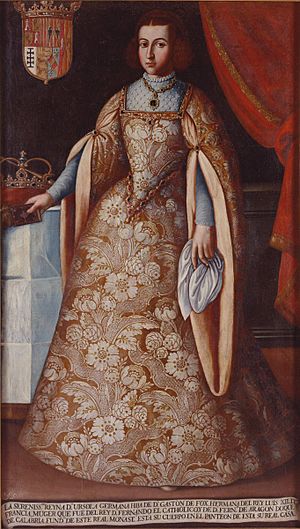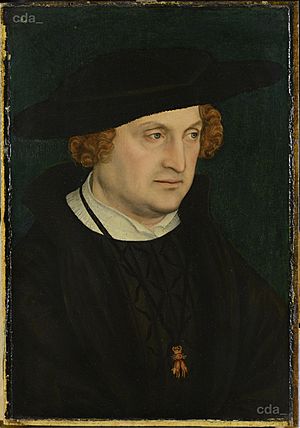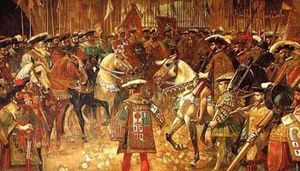Germaine of Foix facts for kids
Quick facts for kids Germaine of Foix |
|||||
|---|---|---|---|---|---|
 |
|||||
| Queen consort of Aragon, Majorca, Valencia, Sardinia, Naples and Sicily Countess consort of Barcelona |
|||||
| Tenure | 22 March 1506 – 23 January 1516 | ||||
| Queen consort of Navarre | |||||
| Tenure | 24 August 1512 – 23 January 1516 | ||||
| Duchess consort of Calabria | |||||
| Tenure | August 1526 – 15 October 1536 | ||||
| Born | Ursule-Germaine de Foix c. 1488 Mazères(?), Kingdom of France |
||||
| Died | 15 October 1536 (aged 48) Llíria, Valencia, Kingdom of Valencia |
||||
| Burial | Monasterio de San Miguel de los Reyes | ||||
| Spouse |
Johann of Brandenburg-Ansbach
(m. 1519; died 1525) |
||||
| Issue Detail |
John, Prince of Girona | ||||
|
|||||
| House | Foix | ||||
| Father | John of Foix, Viscount of Narbonne | ||||
| Mother | Marie of Orléans | ||||
Germaine of Foix (born around 1488 – died October 15, 1536) was a French noblewoman. She became a queen by marrying Ferdinand II of Aragon. She was Queen of Aragon, Majorca, Naples, Sardinia, Sicily, and Valencia from 1506 to 1516. She was also Queen of Navarre from 1512 to 1516.
Later, Germaine served as the Vicereine (a ruler acting for the king) of Valencia from 1523 until her death. She shared this role with her second husband, Johann of Brandenburg-Ansbach, and then with her third husband, Ferdinand, Duke of Calabria. Through her third marriage, she also became the Duchess of Calabria.
Contents
Becoming Queen of Aragon
Why Ferdinand Married Germaine
In 1504, Queen Isabella I of Castile died. She was also Queen of Aragon. Her only living child, Infanta Joanna, inherited the Crown of Castile. Joanna was married to Archduke Philip of Austria. This meant that King Ferdinand II, Isabella's widower and Joanna's father, lost control of Castile. He had only ruled Castile because he was married to Isabella.
Ferdinand worried that after his death, the Crown of Aragon would also go to Joanna and Philip. This would give the powerful House of Habsburg control over most of Spain. To prevent this, Ferdinand hoped to have a son. A son would become the heir to Aragon instead of Joanna.
To achieve this, Ferdinand decided to marry Germaine of Foix. She was the niece of King Louis XII of France. Their engagement was set in 1505. As part of their marriage agreement, Louis XII gave up his claims to the Kingdoms of Naples and Jerusalem to Germaine. This was on the condition that she had a son with Ferdinand. Ferdinand already controlled Naples. Through this marriage, Ferdinand hoped to have a male heir and also gain control of Navarre.
The Royal Wedding
Germaine married Ferdinand by proxy (someone stood in for Ferdinand) on October 19, 1506. She was 18 years old, and Ferdinand was 54. Germaine arrived in Spain at Hondarribia. She was welcomed by Alonso de Aragón, the Archbishop of Zaragoza, who was Ferdinand's son.
She met Ferdinand on March 18, 1507, in Dueñas. Big celebrations followed in Valladolid. This marriage brought a short period of peace between France and Aragon. However, many people in Castile did not like it. They had supported Ferdinand before, but saw his remarriage as a betrayal of their late queen, Isabella. Despite this, the older king was a kind and respectful husband to Germaine.
Ferdinand's son-in-law, Philip, died in September 1506, just weeks after Ferdinand and Germaine married. Ferdinand convinced the Spanish parliament (called the cortes) that Queen Joanna was too unwell to rule. He was then made her guardian and the regent (temporary ruler) of her lands.
On May 3, 1509, Germaine gave birth to a son, Prince John. Sadly, he died shortly after his birth. The couple did not have any more children. If John had lived, the Crown of Aragon would have separated from the Crown of Castile again. These two crowns had been partly united by the marriage of Ferdinand and Isabella.
In 1513, King Ferdinand gave Germaine the Viscounty of Castellbó. This land had belonged to her family, the House of Foix. Germaine was not very involved in politics. However, she did represent her husband at the Cortes Generales in 1512 and the Cortes of Aragon in 1515. She was leading the latter meeting when she heard that her husband was dying. She quickly went to his side in Madrigalejo.
After Ferdinand's Death
King Ferdinand died on January 23, 1516, after two years of health problems. In his will, he left Germaine several towns and lands. He also asked his grandson, Archduke Charles, to take care of her. Charles was Queen Joanna's son and had grown up in the Netherlands.
Charles arrived in Castile in 1517. Germaine moved closer to his court and lived in a monastery. At first, Charles, who was only 12 years younger than Germaine, showed her great respect. But he soon stopped these courtesies. He did, however, give her more lands. Around this time, people described Germaine as "not very beautiful, a bit lame, and someone who loved relaxing and going to parties."

In 1519, Charles traveled to Aragon to be crowned king. Germaine went with him. In Barcelona, Charles arranged for Germaine to marry Johann of Brandenburg-Ansbach. Johann was a German noble without much land. He was a cousin of a powerful prince whose vote Charles needed to become the Holy Roman Emperor. Germaine and Charles then traveled to Germany, where she married Johann.
Vicereine of Valencia
In 1523, Charles appointed Germaine and Johann as the viceroys of Valencia. In this role, Germaine had to deal with the aftermath of the Revolt of the Brotherhoods. This was a rebellion from 1519 to 1523 by artisan guilds against the monarchy and feudal lords.
Germaine punished the rebels, known as agermanats, very harshly. She is believed to have signed the execution orders for 100 former rebels. This was a much stricter approach than her predecessor, who had tried to bring peace. In December 1524, Germaine signed a pardon that officially ended the hunt for all agermanats. However, the guilds and cities that had rebelled had to pay large fines for many years.
Germaine's second marriage to Johann was not happy. Johann was a violent person and behaved badly. They had no children, and he died in 1525. Germaine remarried a year later, in August 1526, to Ferdinand, Duke of Calabria. He was the son of the former king of Naples.
Germaine and Ferdinand, Duke of Calabria, were great supporters of literature and music. They had poets and musicians at their court. They also collected old Greek and Latin books. Germaine worked to slowly bring Valencia more in line with Castile-dominated Spain. Some historians believe that Germaine's move to Valencia led to the decline of the Valencian language among the upper classes. This is because they started using Castilian Spanish to please her.
Germaine died on October 15, 1536, in Llíria, Valencia, at age 48. She likely died from a health problem. She was buried in the Monasterio de San Miguel de los Reyes (Saint Michael of the Kings Monastery), which she had helped to establish. Her third husband lived for 14 more years and remained Viceroy of Valencia until his death in 1550. He remarried and continued to support the arts.
Issue
- With her first husband, Ferdinand II of Aragon (married 1505 or 1506):
- John, Prince of Girona (born and died May 3, 1509). He died just a few hours after his birth.
Images for kids
See also
 In Spanish: Germana de Foix para niños
In Spanish: Germana de Foix para niños






